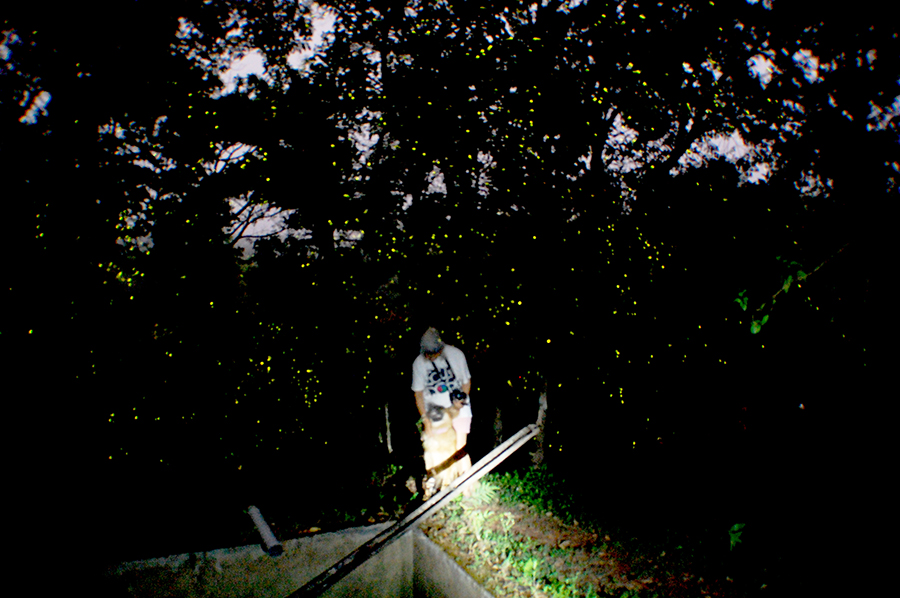Herptofauna and Ground Orchids
September and October mark the end of the monsoon and is like springtime here with many flowers blossoming and birds and butterflies re-emerging. Several ground orchid species can be seen flowering in the grasslands including
Pectelis Gianteca, Habenarium, and Satyrum. The epiphytic Dendrobium Aqueum also blossoms at this time.
This is also the time we see an amazing, unidentified, blue cricket.
The amphibians are still active and many species of tadpoles (especially Malabaricus and Lateralis, and Ramenella) can be seen undergoing metamorphosis and emerging from the tanks. This is also the best
season to spot rare Shieldtail snakes that normally burrow in the ground.
Farm activities: Cardamom harvest — Cardamom panicles are full of fruit, ready to harvest. Freshly-picked cardamom is dried indoors.
Weather: As the monsoon recedes, rains continue but are interspersed with more clear, sunny days.
Temperature Range: 14°-26°C (57°-79°F)
Recommendations: Days surrounding the Dasara and Diwali holidays fill up rapidly. Please remember to bring raingear, since showers will occur
sporadically. Also bring a flashlight and good hiking boots.
Blossoms, Butterflies and Blue Skies
This is the season for birds, butterflies, blossoms and blue skies. Our winter visitors
such as golden orioles and paradise flycatchers arrive and blossoms such as
thunbergia attract many of species of butterflies and birds. The chilly nights with clear
skies are ideal for stargazing and mornings are full of mist.
Farm activities: Cardamom harvest continues and we also harvest our ginger and tumeric. Arabica coffee ripens and harvest begins in December.
Weather: During the winter months, you can expect cool, pleasant days — most often sunny with a breeze.
Temperature Range: 8°-24°C (46°-75°F)
Recommendations: Winter is a wonderful time to visit. Because this is the holiday season — both in India and abroad — make sure to book your reservations early, as rooms may fill up quickly. Bring long sleeves, hiking boots
and a warm jacket.
Orchids, Birds and Coffee
One of the major attractions in this dry season is the blossoming of many wild orchid species. Some trees are covered with these epiphytes and seeing them blossom is a memorable sight. The commonly seen ones include Dendrobium
gerdonianum, Dendrobium Barbatulum, Bulbophyllum tremulum, Bulbophyllum fimbriatum, Celogyne breviscapa, Pachystoma pubesence, Papilionanthe cylinderica, Trias
stocksii.
This is also a great season for birding — many species can be seen in pairs and small groups as they
engage in mate selection and nesting.
Farm activities: Most of the coffee berries ripen to a deep red. They are sweet to the taste and ready for harvest. Vanilla is also harvested and processed at this time.
Weather: The winter weather breaks by January end and February is markedly warmer with a possibility of showers.
Temperature Range: 8°-24°C (46°-75°F)
Firefly Season
April is a magical time at the Rainforest Retreat. Every year at this time nature displays one of its true spectacles — the synchronized flashing of thousands of fireflies. It’s a sight to behold that cannot be put into words. The
images below have been captured by Anurag in April 2016 and 2017.
They start off in small numbers in the last week of March and by the second week of April, they build up to an amazing crescendo where entire valleys flash in unison. Each season varies depending on climate conditions, but the
second and third weeks of April are when the numbers are at their peak before decreasing.
Farm activities: In March, the passing blossom showers induce the coffee plants to blossom, and their fragrance is sweet and sublime. Vanilla flowers emerge and must be hand-pollinated in order to produce the beans. Pepper
is harvested in March and vanilla pollination continues into April. It is a busy time with preparation and application of compost and various mixes.
Weather: During the summer months, the temperatures begin begin to rise. Expect pleasant—and occasionally hot—weather, with passing 'blossom' showers.
Temperature Range: 16°-30°C (61°-86°F)
Pre-monsoon and gliding frogs
With our numerous streams, tanks and dense canopy, Mojo is a hot-spot for amphibians. The tree frogs in particular become active with the early rains in May and June as they have been patiently waiting in the canopies. It is
also the nesting season for the Malabar grey hornbills which we have documented here at Mojo.
We have documented several rare species of amphibians here, but the gliding frogs (Rhacophorus malabaricus and its smaller and extremely rare cousin Rhacophorus lateralis) seem to be a favorite with everyone.
They are present in good numbers at several different sites on the property—you don’t have to go hunting for them. There is no better place than Mojo to see and photograph these unique creatures.
Another ‘Malabar’ native that is closely associated with the gliding frogs is Trimeresurus malabaricus — the Malabar pit viper. They seem to find each other quite frequently, and judging from the time it took this snake to
subdue it, the gliding frogs may have evolved some immunity to the pit viper's venom.
The early monsoon in June is the best time to experience the amazing herptofauna at Mojo.
Farm activities: We are busy finishing compost applications, and other preparations for monsoon include collecting and storing dry wood, clearing water channels, waterproofing buildings.
Weather: One can expect warm days interspersed with thunderstorms during pre-monsoon showers in May. Monsoon typically arrives in early June.
Temperature Range: 18°-22°C (64°-72°F)
Natural History: The monsoon quickly transforms the rainforest. This season marks the breeding season for frogs; at night, the forests come alive with the songs of many species. In many ways, the true essence
of the rainforest is best experienced during monsoon rains — it is this extreme rainfall which enables such great biodiversity and natural bounty.
Monsoon
July and August are the peak rain months when you can experience the southwest monsoon in all its glory. It is a special time when nature is at its most intense with many dormant plants and animals coming to life. Rare epiphytic impatiens and orchids are in blossom and amphibians and herps are in their element just waiting to be photographed.
We are in one of the highest rainfall areas of Kodagu so bring your rain gear, leech socks, and cameras for a unique experience.
Farm activities: July and August are the beginning of the cardamom harvest at Mojo.
Weather: One can expect almost continuous (medium to high intensity) rain, but when the sun does peek out it's a real treat.
Temperature Range: 18°-22°C (64°-72°F)
Natural History: The monsoon quickly transforms the rainforest. This season marks the breeding season for frogs; at night, the forests come alive with the songs of many species. In many ways, the true essence of the rainforest is best experienced during monsoon rains — it is this extreme rainfall that enables such great biodiversity and natural bounty.



